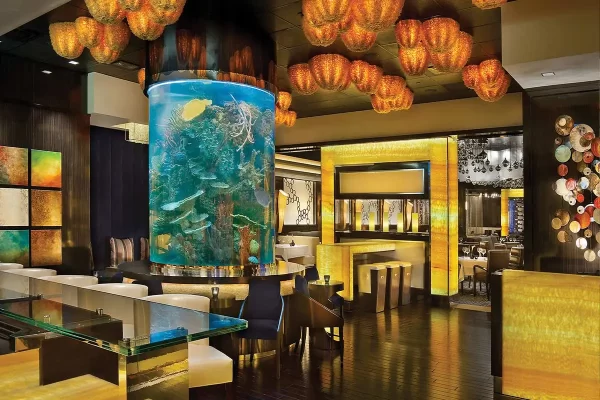When you look up the definition of modular, the result is generally along these lines: Designed with standardized units for easy assembly and repair; constructed with standardized dimensions for flexibility and variety in use. The beauty of modular architecture is that you can replace or add any one component without affecting the rest of the system.
In the exhibit industry, the meaning of modular has lost much of its precision as it applies to architectural systems. Because of similar functionality (walls, towers, decks), modular has been lumped in with portables and extrusion systems. That, in a word, is misleading.
Architectural Modularity
Before you start picturing modular exhibits that you’ve seen, or think you’ve seen, at tradeshows, consider one of the quintessential examples of a modular structure. The Contemporary, one of the first two resort hotels at Disney World, was built as an A-frame. Its outer walls slope inwards around an inner atrium. The design was a collaboration between Disney, the U. S. Steel Corporation and Los Angeles-based architect Welton Becket. To construct the building, steel frames were erected on-site with modular, pre-constructed rooms. It was designed by California-based architect Donald Wexler, the father of mid-century modern architecture, and lifted into place by crane. After that, most of Disney’s Polynesian Resort and the Court of Flags Resort were built the same way, except that the rooms were stacked instead of slid in.
Wexler’s values were rooted in adaptability and flexibility as well as in his conception of space, systems and materials. This approach made him a pioneer in the exploration of modularity and the use of light steel framing for construction. One of his first steel-framed systems consisted of a light-gauge structural steel frame, steel roof decking and wall panels. These elements comprised the basic structural modules, and since they were lightweight and structurally independent, they could be relocated. The wall panels were designed in 8-foot modules, allowing flexibility as well as the feasibility of expanding the size of the structure.
Modularity and its Impact on the Exhibit Industry
Today, aluminum modular structures provide a green approach to exhibiting by avoiding the use of wood, repurposing the modules and providing less of an environmental impact when shipping.

But what constitutes modular exhibitry? Turning to Kerstin Mulfinger, a German architect and consultant to the exhibit industry on the subject, we asked for some hallmarks.
“A modular exhibit has a fixed grid size as opposed to custom elements,” said Mulfinger. “You can take parts from a pool, like Tinker Toys. There are endless possibilities for building with modular components because they are very flexible.
“Because it is possible to rent modular pieces from an inventory and create new structures, there is unlimited re-use. It is very green. I have found that the better the system, the less you are confined in your design and build and the more flexibility you have. Modular components are invaluable for accommodating exhibits of different sizes or creating hybrid exhibits.”
But confusion can arise when modular exhibits are lumped in with extrusion systems.

“As Kerstin said, modular components work on a grid system, and because of this, they are easy to put together,” said Chris Lake, COO, Highmark TechSystems. “Because many of the modular systems are aluminum, they are lightweight, economical and very flexible. They allow you to customize the shape and scale of your design, and they blend well with custom elements in a hybrid exhibit. There aren’t lots of parts and pieces to assemble.”
The future of modular
“As exhibitors direct their spending to customer-facing initiatives, they are going to ask for solutions that are economical on the backend,” said Lake. “They want to use their exhibit budgets in ways that help them connect with their customers. They don’t want to spend the lion’s share of their dollars on getting the exhibit on and off the trucks, on to the floor and set up. Aluminum modular exhibits give them that freedom. And in addition to their versatility, they are reusable and recyclable. Today, many corporations have taken a stand for sustainability. Modular exhibits enhance that position and are consequently good for those brands.”
In partnering with exhibit builders and designers to redefine the use of modular exhibits, there is a return to Wexler’s values of adaptability, flexibility and reusability.
“We’ve built our whole company around the theory and virtues of modular thinking,” said Lake. “Our mission is to help our customers understand the value and benefits of using modular exhibits whether they do so as a purchase with a new booth or as a custom rental. And today, we feel we’re redefining modular.”





























